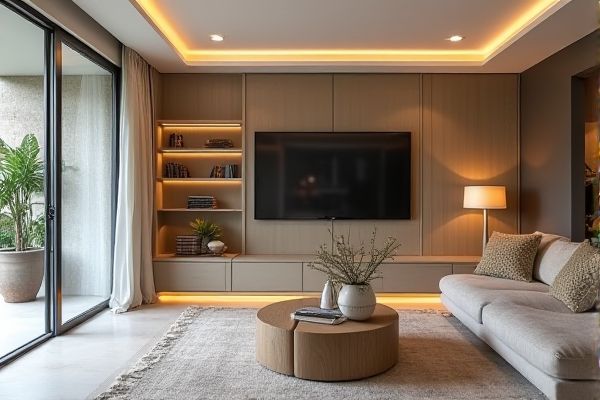
Modular furniture offers flexibility and easy customization to fit changing spaces and styles, while built-in furniture provides a seamless, permanent solution tailored specifically to your home's architecture. Discover which option best suits your lifestyle and enhances your living space by reading the rest of this article.
Table of Comparison
| Feature | Modular Furniture | Built-in Furniture |
|---|---|---|
| Flexibility | Highly flexible, easy to rearrange and customize | Fixed design, limited flexibility after installation |
| Installation | Easy, no structural changes required | Requires professional installation and modifications to walls |
| Cost | Generally affordable with varied price options | More expensive due to custom design and installation |
| Space Utilization | Good for open spaces, less efficient in odd-shaped rooms | Optimized for specific spaces, maximizes room utilization |
| Customization | Moderate, based on available modules | High, fully customized to client needs and space |
| Durability | Varies by material, often less durable than built-in | Typically more durable and long-lasting |
| Mobility | Portable and easy to move | Permanently fixed, not movable |
| Design Integration | May not blend seamlessly with room architecture | Seamlessly integrates with room design and architecture |
Introduction to Modular and Built-in Furniture
Modular furniture consists of versatile, standalone pieces designed for easy rearrangement and customization, making it ideal for dynamic living spaces. Built-in furniture is permanently installed and tailored to fit specific structural dimensions, maximizing space efficiency and providing a seamless aesthetic. Your choice depends on flexibility needs, space constraints, and desired interior style.
Key Differences Between Modular and Built-in Furniture
Modular furniture offers flexibility with pre-made, movable units that can be easily reconfigured, while built-in furniture is custom-designed and fixed to your space, providing a seamless, integrated look. Modular designs allow for easy installation and adaptability to changing needs, whereas built-in furniture maximizes space efficiency and adds permanent value to your home. Your choice depends on whether you prioritize versatility or a tailored, long-lasting solution.
Design Flexibility: Modular vs Built-in
Modular furniture offers exceptional design flexibility with its easy rearrangement, customization, and adaptability to changing spaces or needs. Built-in furniture, while often providing a seamless and integrated look, lacks the ability to be moved or reconfigured once installed, limiting future modifications. Your choice depends on whether you prioritize adaptability for evolving designs or a permanent, tailored fit.
Space Utilization and Optimization
Modular furniture offers flexible space utilization by allowing you to rearrange or expand pieces based on your changing needs, making it ideal for dynamic environments. Built-in furniture maximizes fixed space optimization by seamlessly integrating storage and functional elements into walls or corners, creating a streamlined and clutter-free area. Both options enhance your living spaces, but modular furniture adapts more easily to different layouts while built-in solutions provide a permanent, space-saving structure.
Installation Process and Timeline
Modular furniture offers a quick and straightforward installation process, often completed within a few hours due to its pre-fabricated components and flexible design. Built-in furniture requires professional measurement and custom fabrication, resulting in a longer timeline that can span several days or weeks depending on complexity. Your choice impacts renovation schedules, with modular furniture ideal for immediate use and built-in solutions providing a tailored, permanent fit.
Cost Comparison: Modular vs Built-in
Modular furniture generally offers a lower upfront cost compared to built-in furniture due to its mass production and ease of installation. Built-in furniture typically incurs higher expenses because of custom design, labor-intensive installation, and materials tailored to specific spaces. While modular units provide flexibility and affordability, built-in options often add long-term value through durability and seamless integration with architecture.
Customization and Personalization Options
Modular furniture offers extensive customization options, allowing you to mix and match components to fit your unique space and style preferences. Built-in furniture provides a high level of personalization through tailor-made designs that seamlessly integrate with your room's architecture. Choosing between these options depends on whether you prioritize flexibility and adaptability or a permanent, bespoke solution.
Maintenance and Longevity
Modular furniture offers easy maintenance and flexibility, allowing you to replace or repair specific units without impacting the entire setup, which extends its longevity. Built-in furniture, while often more durable due to its custom fit and sturdy installation, can be more challenging and costly to maintain or modify over time. Choosing between modular and built-in furniture depends on your preference for ease of upkeep versus long-term durability.
Aesthetic Appeal and Style Considerations
Modular furniture offers versatile design options with customizable configurations that adapt to evolving aesthetic trends and personal tastes, making it ideal for dynamic lifestyles. Built-in furniture provides a seamless, cohesive look that enhances architectural features and maximizes space, contributing to a polished, permanent style statement. Your choice depends on whether you prioritize flexibility and modern appeal or a tailored, integrated design that complements your home's unique character.
Choosing the Right Furniture Solution for Your Space
Modular furniture offers flexibility with customizable configurations, ideal for adapting to changing spatial needs and maximizing functionality in smaller areas. Built-in furniture provides a seamless, permanent solution that enhances room aesthetics and optimizes every inch of available space through tailored designs. Evaluating your lifestyle, space limitations, and future needs is crucial to selecting between the versatile adaptability of modular pieces and the enduring integration of built-in units.
 homyna.com
homyna.com